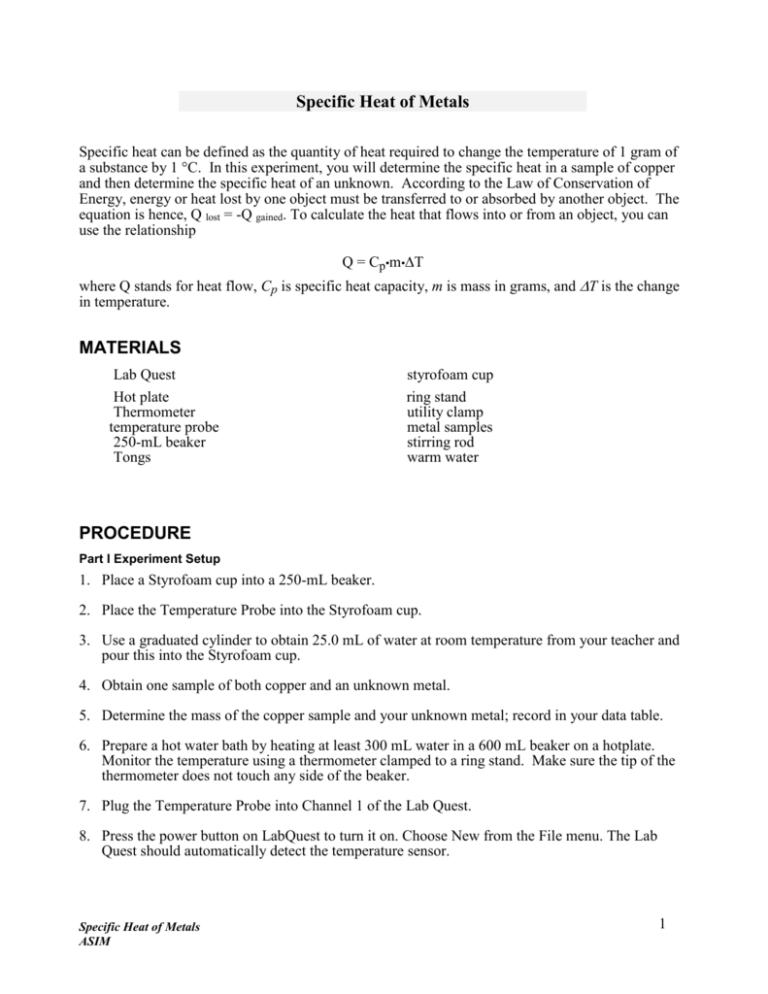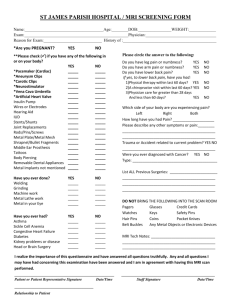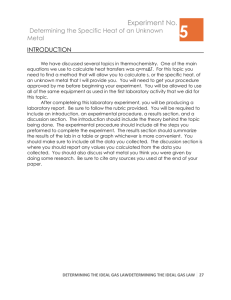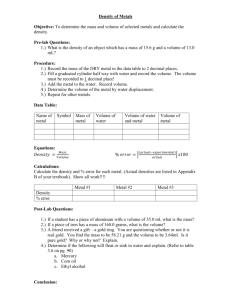Specific Heat of Metals Calc DM
advertisement

Specific Heat of Metals Specific heat can be defined as the quantity of heat required to change the temperature of 1 gram of a substance by 1 °C. In this experiment, you will determine the specific heat in a sample of copper and then determine the specific heat of an unknown. According to the Law of Conservation of Energy, energy or heat lost by one object must be transferred to or absorbed by another object. The equation is hence, Q lost = -Q gained. To calculate the heat that flows into or from an object, you can use the relationship Q = Cp•m•T where Q stands for heat flow, Cp is specific heat capacity, m is mass in grams, and T is the change in temperature. MATERIALS Lab Quest Hot plate Thermometer temperature probe 250-mL beaker Tongs styrofoam cup ring stand utility clamp metal samples stirring rod warm water PROCEDURE Part I Experiment Setup 1. Place a Styrofoam cup into a 250-mL beaker. 2. Place the Temperature Probe into the Styrofoam cup. 3. Use a graduated cylinder to obtain 25.0 mL of water at room temperature from your teacher and pour this into the Styrofoam cup. 4. Obtain one sample of both copper and an unknown metal. 5. Determine the mass of the copper sample and your unknown metal; record in your data table. 6. Prepare a hot water bath by heating at least 300 mL water in a 600 mL beaker on a hotplate. Monitor the temperature using a thermometer clamped to a ring stand. Make sure the tip of the thermometer does not touch any side of the beaker. 7. Plug the Temperature Probe into Channel 1 of the Lab Quest. 8. Press the power button on LabQuest to turn it on. Choose New from the File menu. The Lab Quest should automatically detect the temperature sensor. Specific Heat of Metals ASIM 1 9. On the Meter screen, tap Rate. Change the data-collection rate to 0.5 samples/second (interval of 2 seconds/sample) and the data-collection length to 180 seconds. Select OK. Select OK again to return to the main screen. 10. When the temperature of your hot water bath reaches 85 °C, carefully hold your copper sample with a pair of tongs in the hot water bath for one minute, being careful not to allow the metal to touch any side of the beaker. 11. Press START on your Lab Quest to begin recording data. After a couple of seconds, immerse your copper sample into the cup of room temperature water. Use your temperature probe to continually stir the mixture throughout data collection. 8. As soon as data collection ends, the Lab Quest will autoscale your data into a graph. PROCESSING THE DATA 1. Use the left and right cursors to move along the graph to find the minimum or initial temperature for the water. This is the point on the graph just before the metal is added. Move the cursor to the highest point of the graph and record this as the maximum or final temperature. Record in data table. Use the equation T = Tf – Ti to determine T, the change in water temperature. 2. Determine the heat gained by the water using the formula Q = Cp•m•T. Use 4.184 J/g C for the specific heat of water. Assume that no heat is absorbed by the calorimeter. Q gained by water = Cp(water) m(water) T(water) Cp(water) = 4.184 J/g °C T(water) = T final, mix – T initial, water 3. Determine the heat lost by the copper sample using the same heat equation. The specific heat for copper is in the table at the end of the lab. Q lost by metal = Cp(metal) m(metal) T(metal) T(metal) = T final, mix – T initial, metal 4. How does the heat lost compare to the heat gained? 5. Repeat the experiment using the unknown piece of metal. Be sure to get new water. 6. Determine the heat gained by the water in Trial 2. Q gained by water = Cp(water) m(water) T(water) Cp(water) = 4.184 J/g °C T(water) = T final, mix – T initial, water Specific Heat of Metals ASIM 2 7. Assuming complete transfer of heat from the metal to the water, determine the specific heat from the metal. Q lost by metal = Cp(metal) m(metal) T(metal) Cp(metal) = what you are trying to solve T(metal) = T final, mix – T initial, metal 8. Use the table at the end of the lab to determine your unknown metal. 9. Using the accepted value for the specific heat of your metal, calculate the percent error for your experiment. 10. If time permits, repeat experiment with a second unknown. Specific Heat of Metals ASIM 3 NAME__________________________________________ DATA AND CALCULATIONS TRIAL 1 Mass of sample, m G Initial water temperature, Ti °C Initial metal temperature, Ti °C Final temperature of mixture, Tf °C Change in water temperature, T °C Change in metal temperature, T °C J/g °C Specific Heat of known metal, Cp % Percent Error for known metal TRIAL 2 Mass of unknown sample, m G Initial water temperature, Ti °C Initial unknown metal temperature, Ti °C Final temperature of mixture, Tf °C Change in water temperature, T °C Change in unknown metal temperature, T °C J/g °C Specific Heat of unknown metal, Cp Identity of unknown metal % Percent Error for unknown metal TABLE OF RELATIVE SPECIFIC HEATS Aluminum Carbon Copper Gold Iron Lead Tin Zinc Specific Heat of Metals ASIM 0.900 J/g °C 0.711 J/g °C 0.387 J/g °C 0.129 J/g °C 0.450 J/g °C 0.128 J/g °C 0.210 J/g °C 0.390 J/g °C 4 QUESTIONS 1. How does the heat conductivity of the metals used in this experiment affect the accuracy of the results? 2. Why is it important to heat the water bath to at least 85 °C before inserting your metal sample? Explain. 3. What effect, if any, would a delay in transferring the metal sample into the calorimeter have on the value of the change in temperature? On the specific heat value of the metal? Specific Heat of Metals ASIM 5








